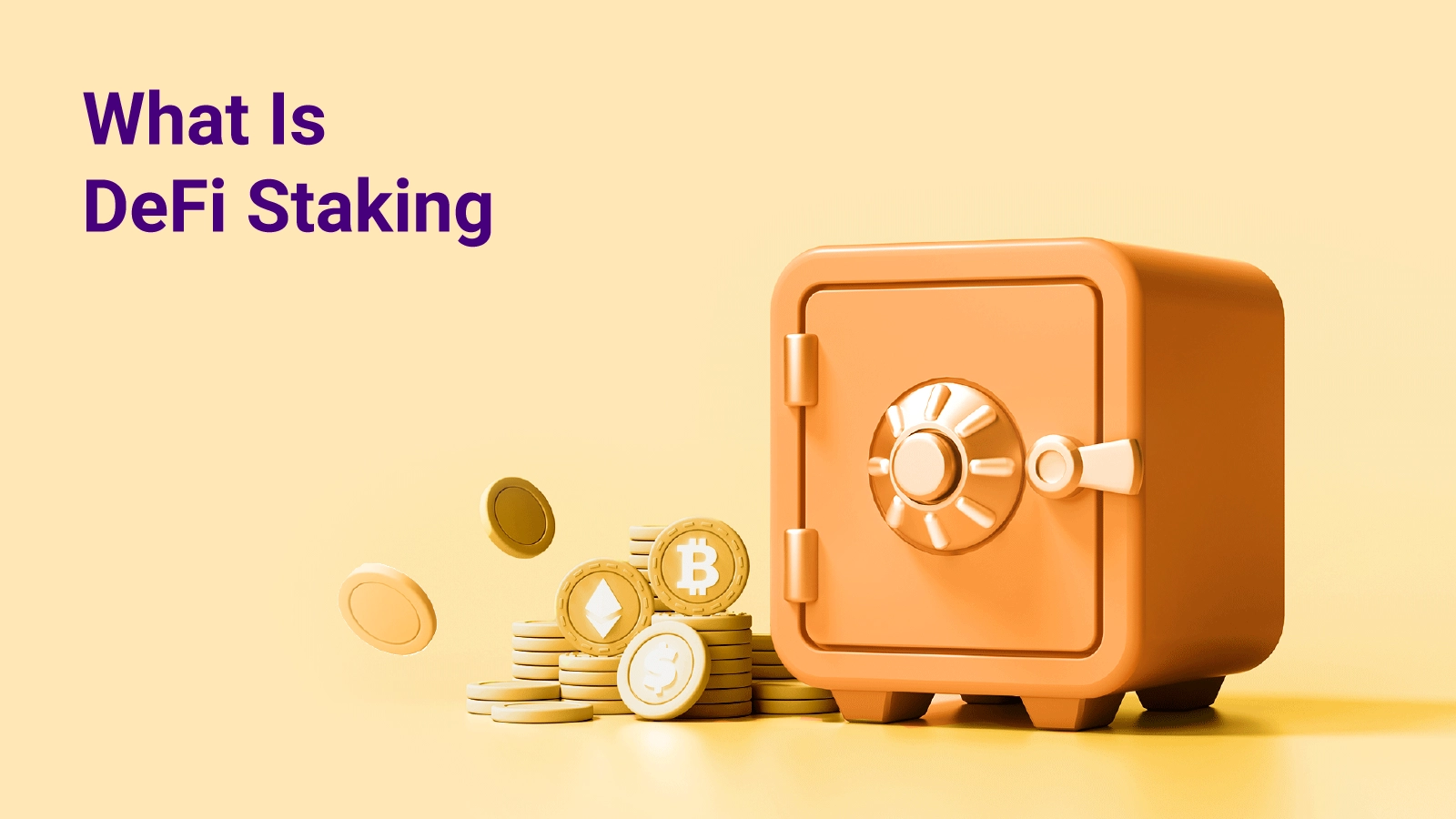
Bank Deposit vs DeFi Staking [The Ultimate Guide 2023]
Cryptocurrency investors worldwide earn rewards created through crypto lending and staking. Many DeFi protocols offer great incentives for those who stake crypto and lock them into a smart contract platform by providing interest on investment and governance tokens. The top peer-to-peer (P2P) crypto lending platforms offer high yields to investors who deposit assets into exchanges and low-interest crypto loans to borrowers who collateralize loans with their crypto assets.
DeFi is one of the most important innovations of blockchain technology, revolutionizing the foundations of traditional financial systems and redefining traditional financial services such as lending, trading, investment, payment, insurance, etc., by disrupting the role of intermediaries.
DeFi staking offers a high yield for staking coins; however, it lacks the security provided by centralized finance when your money is held by third parties, such as banks, in a standard savings account. While the interest rate offered for traditional bank deposits is much lower than the staking yields in the DeFi space, all savings accounts are covered by FDIC insurance at each insured bank, including principal and any accrued interest.
If you’re facing a dilemma about which passive income option to choose, we got you covered. This article will look into how staking and DeFi lending work compared to traditional bank deposits and help you choose the option that works for you.
Let’s get right to it!
What Is DeFi
Decentralized finance (DeFi) is an umbrella term for a peer-to-peer, decentralized, and trustless network of financial services. To better understand decentralized finance, let’s look into centralized finance first.
What Is Centralized Finance
All major financial services we use daily, including banking services, stocks, bonds, commodities markets, etc., are part of the centralized financial system. In this system, a central authority or an intermediary monitors and governs all financial transactions, like lending, borrowing, banking, trading, etc., making them more complicated, lengthy, and expensive. As such, it takes weeks or even months to secure a loan under a centralized financial system. Moreover, the loan is only secured after your credit score and history are approved. As a result, many people on the margins of society are deprived of financial services. Additionally, significant losses have been recorded due to these intermediaries’ inherent greed or corruption, as seen during the 2008 financial crisis.
Bitcoin offered an answer to all the shortcomings of traditional finance, and the Ethereum blockchain has paved the way for the mass adoption of DeFi across the globe.
Decentralized Finance (DeFi)
Decentralized finance redefines traditional financial services such as lending, trading, investment, payment, insurance, etc., by disrupting the role of intermediaries.
DeFi uses distributed ledger technology (DLT) or blockchain to enable almost instantaneous peer-to-peer financial transactions and payments using cryptocurrencies. The instantaneous and low-cost DeFi transactions also play a significant role in scalability. DeFi replaces intermediaries with smart contracts, which are self-executory. A smart contract is a code written on the blockchain network that contains all the pre-agreed conditions necessary to make a transaction successful. Moreover, DeFi provides access to financial systems to anyone with an internet connection. The funds are stored in a decentralized crypto wallet like the CoinStats Wallet and can be used just like regular money.
How Does DeFi Work
Decentralized finance is a trustless network where users are given complete control over their assets and investments. DeFi uses distributed ledger technology (DLT) or blockchain and stores all the data about the transactions on the blockchain. DeFi applications handle all the transactions on the blockchain. The transactions carried out on these blockchains are validated by network users without the control of institutions.
In a Proof-of-work (PoW) consensus mechanism, mining is used to validate transactions, whereas, in a Proof-of-Stake (PoS) consensus mechanism, the staking process is used for verifying transactions.
This creates a financial system free from the control of institutions and central authorities. Users have complete control over their digital assets, and all they need to access DeFi services is a device with an internet connection.
Decentralized Finance Use Cases
DeFi is an emerging financial technology with several real-world use cases, including:
Decentralized Exchange
Decentralized exchanges are digital marketplaces where individuals can trade in cryptocurrencies, NFTs and even stake their crypto assets to earn interest. A decentralized crypto exchange (DEX) is not governed by any middleman or centralized business; instead, it operates over blockchain and charges no fee except for the gas fee applicable on a particular blockchain. The fees that a market maker or a trading firm used to earn, DEX users can instead earn by investing in a liquidity pool. DEXs are non-custodial and rely on liquidity provided by users through yield farming or liquidity mining.
On the other hand, centralized exchanges are the most popular exchanges for trading cryptocurrencies, even though they charge an exchange commission for using their services.
Sending Money
By using decentralized apps, users can send money instantly from one part of the world to another, and the only fee charged is the network fee. Similar transactions in traditional finance take days and even weeks in some cases and accrue transaction fees as well. Money transfers on DApps happen in real-time and are efficient due to automated smart contracts.
Stablecoins
Stablecoins are crypto assets pegged against real-world assets such as fiat currencies, gold, etc. Most stablecoins are pegged against the U.S. dollar, e.g., USDT, USDC, DAI, etc.
DeFi Lending
DeFi lending has become one of the most popular means of earning passive income on your crypto assets. According to DeFi Pulse, the total value locked (TVL) in DeFi applications stands at $1.01 billion, and more than 75 percent is locked in lending services. Unlike traditional finance, where you must meet certain eligibility criteria to secure a loan, anyone can get a crypto loan easily.
Crypto lending works like a savings account at a bank. Lenders deposit their crypto assets into a pool of funds that others can borrow from and earn interest on their holdings. However, unlike a bank deposit, the funds in the pool aren’t FDIC insured.
There are two types of borrowing – peer-to-peer borrowing and borrowing from liquidity pools. In peer-to-peer lending, individuals can borrow from one another directly using smart contracts, whereas, in liquidity pool-based borrowing, lenders provide market liquidity in the form of cryptocurrency assets to the lending pools.
The lending and borrowing rates are determined by the DeFi protocol and the network liquidity. A share of transaction fees, interest from lenders, or a governance token can all be used as incentives, and these returns are typically expressed as an annual percentage yield (APY).
DeFi Staking
DeFi staking is a rewards-type system that involves locking crypto assets in your cryptocurrency wallet for a specific period to verify transactions, contribute to the blockchain network’s performance and safety, and earn staking rewards in return.
On Proof-of-Stake blockchains that support staking, users who stake coins in the network to validate blocks on that blockchain and verify transactions are called nodes or validators.
The total staking market cap is over $18.5 billion, with over $9.9 billion locked in staking, as per Staking Rewards data.
Let’s look into DeFi staking compared to a traditional bank deposit.
Bank Deposit vs. DeFi Staking
One of the most popular ways of earning interest on your investments is with a savings account offered by most banks. While banks pay a regular interest rate on savings, even the best saving account will only pay you an APY of not more than 1-2 percent. This value is barely above the inflation rate in most countries.
Interest rates provided by banks are this low because they use your deposits to generate their own income, such as provide loans or make investments with your money. Some of the profits they make from these business practices are then offered as interest on the deposits.
One of the best features of most traditional bank deposits is that you can withdraw your money from the bank at any point without incurring any penalty in most cases. However, the major disadvantage with bank deposits is that you have no control over your assets, and the banks can freeze your assets or put a cap on how much a person can withdraw during times of financial crisis. Traditional savings accounts also contain low risk since most of them are insured, and fiat currencies tend to be more stable, fluctuating only by a fraction of a percent each day, compared to more than 1% for most cryptocurrencies. And finally, it can take several days to open a savings account — and there’s still the possibility of being rejected.
DeFi staking, on the other hand, provides staking rewards ranging from 5 to 20 percent, with the cryptocurrency staking process usually taking just seconds. However, among the drawbacks of staking is that you can’t withdraw your assets earlier than the end of the staking period, and if you do, you might be charged a penalty or even lose the interest earned. Cryptocurrencies are also unregulated and notoriously volatile, making it quite possible to lose money, despite the additional staking rewards. Additionally, the crypto network creates new coins to be distributed as rewards, increasing the total amount of that crypto in circulation. As new coins are minted, their supply is diluted, resulting in inflation, which also impacts the actual returns you get.
CoinStats Earn is one of the best places where you can earn massive rewards through DeFi staking.
CoinStats Earn

CoinStats Earn is one of the registered trademarks of CoinStats and enables you to stake your crypto assets in some of the best-handpicked protocols with an APY as high as 20 percent. CoinStats Earn gives you complete control over your assets and never asks for your wallet seed phrase. It also provides an inbuilt calculator to help you calculate your estimated rewards before the staking process.
The interface is intuitive and easy to use, even for novices, and the fees charged for staking are minimal.
Conclusion
DeFi services, including crypto staking, will have a significant impact on the financial world, providing investors with new opportunities for earning passive income. With Ethereum moving to a Proof-of-Stake consensus mechanism, even more staking rewards will be available to users choosing DeFi staking as their preferred method of earning passive income.
Remember that while we strive to provide users with unbiased and accurate information, all the information is presented without warranty.
You are also welcome to visit our CoinStats blog to learn more about wallets & exchanges, portfolio trackers, tokens, etc., and explore our in-depth buying guides on how to buy various cryptocurrencies, such as How to Stake on Binance, How to Stake on Coinbase, What Is DeFi, How to Buy Cryptocurrency, etc
Investment Advice Disclaimer: The opinions expressed in this article are provided to you solely for informational purposes and do not constitute a recommendation by CoinStats to buy, sell, or hold any securities, financial product, or instrument mentioned in the content, nor do they constitute investment advice, financial advice, trading advice, or any other type of advice.
Cryptocurrency is a highly risky activity sensitive to secondary activity, do your independent research, obtain your own advice, and only invest what you can afford to lose. There are significant risks involved in trading CFDs, stocks, and cryptocurrencies. Between 74-89% of retail investor accounts lose money when trading CFDs. You should consider your own circumstances and obtain your own advice before making any investment. You should also verify the nature of any product or service (including its legal status and relevant regulatory requirements) and consult the relevant regulators’ websites before making any decision.






